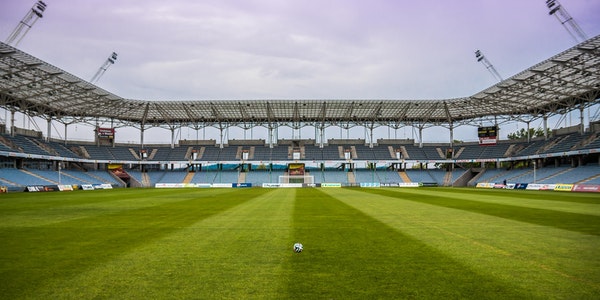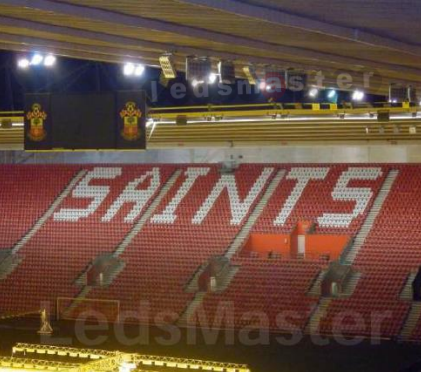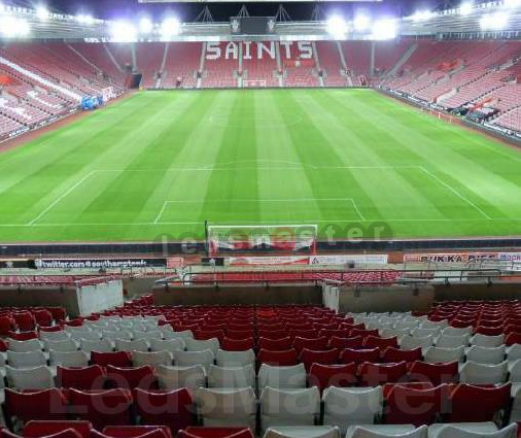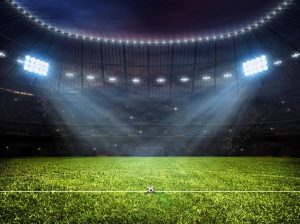- Higher Lumen Output: Advances in LED technology have led to higher lumen output per LED chip, enabling the development of brighter and more powerful lighting fixtures. High-output LEDs deliver exceptional brightness levels, making them suitable for illuminating large outdoor sports facilities such as stadiums, arenas, and sports fields with uniform and high-quality light.
- Improved Color Rendering: LED technology now offers improved color rendering capabilities, allowing for more accurate and vibrant color reproduction. High Color Rendering Index (CRI) LEDs ensure that sports venues are illuminated with natural-looking light that enhances visibility, enhances the viewing experience, and accurately represents team colors and branding.
- Tunable White and Color Control: New LED lighting systems feature tunable white and color control capabilities, allowing organizers to adjust color temperatures and create dynamic lighting effects. By fine-tuning the color temperature of LED fixtures, venues can create different atmospheres for daytime and nighttime events, enhance spectator engagement, and customize lighting to match team colors or event themes.
- Smart Lighting Solutions: Advanced LED lighting systems are equipped with smart controls, sensors, and network connectivity, enabling remote monitoring, scheduling, and automation. Smart lighting solutions allow organizers to optimize energy usage, adjust lighting levels in real time, and integrate lighting with other building systems for improved efficiency, performance, and sustainability.
- Modular and Flexible Designs: LED lighting fixtures now feature modular designs that allow for easy customization, expansion, and upgrades. Modular LED systems offer flexibility in layout, optics, and control options, enabling organizers to adapt lighting solutions to suit different sports, events, and venue configurations.
- Enhanced Durability and Reliability: Advances in LED chip packaging and thermal management technologies have improved the durability and reliability of LED lighting fixtures. Modern LEDs are more resistant to shock, vibration, and environmental factors, ensuring long-term performance and reduced maintenance requirements for outdoor sporting venues.
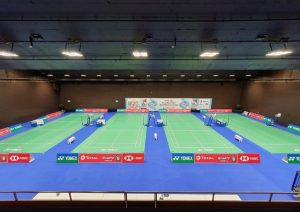
Overall, advances in LED technology continue to drive innovation and improvements in outdoor sports lighting, offering organizers greater flexibility, efficiency, and control over lighting solutions. These advancements contribute to enhanced visibility, sustainability, and the overall fan experience at outdoor sporting events.
B. Integration with smart systems and IoT
Integration of LED lighting technology with smart systems and the Internet of Things (IoT) offers numerous benefits for outdoor sporting events:
- Remote Monitoring and Control: Smart LED lighting systems can be remotely monitored and controlled via a centralized management platform. Event organizers can adjust lighting levels, schedule presets, and troubleshoot issues in real-time, enhancing operational efficiency and minimizing downtime.
- Energy Optimization: IoT-enabled LED lighting systems utilize sensors and data analytics to optimize energy usage based on occupancy, daylight levels, and environmental conditions. By dynamically adjusting lighting levels and schedules, venues can reduce energy consumption, lower utility bills, and meet sustainability goals.
- Predictive Maintenance: Smart LED lighting systems employ predictive maintenance algorithms to detect potential failures and performance degradation before they occur. By analyzing data from sensors and historical usage patterns, venues can schedule proactive maintenance tasks, extend the lifespan of lighting fixtures, and minimize disruptions to sporting events.
- Adaptive Lighting Control: IoT-enabled LED lighting systems offer adaptive lighting control features that respond to changing conditions in real-time. Sensors can detect movement, sound, or weather changes and adjust lighting accordingly to optimize visibility, safety, and comfort for athletes and spectators.
- Integration with Venue Systems: Smart LED lighting systems can be integrated with other venue systems such as security cameras, access controls, and HVAC systems for seamless operation and enhanced functionality. Integrated systems enable coordinated responses to events, improve overall venue management, and enhance the spectator experience.
- Data Analytics and Insights: IoT-enabled LED lighting systems generate valuable data and insights that can be used to optimize venue operations, improve event planning, and enhance fan engagement. By analyzing lighting usage patterns, foot traffic, and crowd behavior, organizers can make data-driven decisions to enhance the overall experience for attendees.
- Personalized Experiences: Smart LED lighting systems can create personalized experiences for spectators through interactive features such as synchronized light shows, dynamic displays, and immersive lighting effects. By engaging fans with customized lighting experiences, venues can enhance brand loyalty, increase attendance, and drive revenue opportunities.
Overall, integration of LED lighting technology with smart systems and IoT offers venues unprecedented control, efficiency, and flexibility in lighting management, enabling organizers to create immersive and memorable experiences for outdoor sporting events.
C. Potential applications in virtual reality and augmented reality
The integration of LED lighting technology with virtual reality (VR) and augmented reality (AR) offers exciting opportunities to enhance immersion, interactivity, and visual experiences in outdoor sporting events:
- Enhanced Immersion: LED lighting systems can be synchronized with VR and AR environments to enhance immersion and create more realistic and engaging experiences for users. By dynamically adjusting lighting levels, colors, and effects to match virtual environments, LED technology can blur the line between physical and virtual worlds, transporting users into immersive sporting environments.
- Interactive Lighting Effects: LED lighting systems can be integrated with VR and AR applications to create interactive lighting effects that respond to user actions and environmental stimuli. For example, LED fixtures can change colors, patterns, or intensity levels in real-time based on user interactions within virtual or augmented environments, adding an extra layer of interactivity and engagement.
- Spatial Awareness and Depth Perception: LED lighting technology can be used in conjunction with VR and AR systems to enhance spatial awareness and depth perception for users. By illuminating physical surroundings with dynamic lighting effects that complement virtual content, LED lighting can help users better navigate and interact with virtual environments, improving overall immersion and usability.
- Spectator Experiences: LED lighting systems can enhance spectator experiences in outdoor sporting events by integrating VR and AR elements into live broadcasts or stadium displays. For example, LED screens can overlay augmented reality graphics or statistics onto live video feeds, providing spectators with additional information and insights during games or events.
- Mixed Reality Experiences: LED lighting technology can facilitate mixed reality experiences that blend physical and virtual elements seamlessly. By synchronizing LED lighting with VR and AR content, organizers can create interactive installations, immersive exhibitions, or mixed reality attractions that captivate audiences and enhance the overall event experience.
- Branding and Sponsorship Opportunities: LED lighting systems can be leveraged to create innovative branding and sponsorship opportunities in VR and AR environments. For example, LED displays can showcase sponsor logos, advertisements, or branded content within virtual arenas or augmented reality overlays, allowing sponsors to reach audiences in new and engaging ways.
- Accessibility and Inclusivity: LED lighting technology can improve accessibility and inclusivity in outdoor sporting events by providing enhanced visual cues and navigation aids for users with disabilities. By integrating LED lighting with VR and AR applications, organizers can create inclusive experiences that accommodate diverse audiences and cater to individual needs and preferences.
Overall, the integration of LED lighting technology with virtual reality and augmented reality opens up exciting possibilities for enhancing immersion, interactivity, and visual experiences in outdoor sporting events. By leveraging LED technology in conjunction with VR and AR platforms, organizers can create immersive environments, engage audiences in new ways, and elevate the overall event experience to new heights.
VII. Conclusion
A. Recap of the benefits of LED lighting in outdoor sporting events
LED lighting technology offers numerous benefits for outdoor sporting events, including:
- Energy Efficiency: LED fixtures consume less electricity, resulting in lower energy bills and reduced environmental impact.
- Cost Savings: LED lighting systems have lower operating and maintenance costs compared to traditional lighting sources.
- Enhanced Visibility: LEDs provide uniform illumination, improving visibility for athletes and spectators.
- Customizability and Flexibility: LED lighting allows for customizable color temperatures, brightness levels, and dynamic lighting effects.
- Longevity and Durability: LED fixtures have a longer lifespan and are more resistant to shock, vibration, and environmental factors.
- Environmental Sustainability: LED technology reduces carbon emissions, conserves resources, and minimizes light pollution.
- Integration with Smart Systems: LED lighting systems can be integrated with smart controls and IoT platforms for remote monitoring, energy optimization, and predictive maintenance.
- Immersive Experiences: LED lighting can enhance immersion, interactivity, and visual experiences when integrated with virtual reality and augmented reality technologies.
Overall, LED lighting technology offers a comprehensive solution for outdoor sporting events, combining energy efficiency, cost savings, enhanced visibility, and environmental sustainability to create memorable experiences for athletes, spectators, and organizers alike.
B. Affirmation of its growing popularity and widespread adoption
Indeed, LED lighting technology has experienced a surge in popularity and widespread adoption across outdoor sporting events worldwide. From local community sports complexes to major stadiums hosting international competitions, LED fixtures have become the lighting solution of choice for organizers seeking to enhance performance, efficiency, and sustainability. The benefits of LED technology, including energy efficiency, cost savings, enhanced visibility, and environmental sustainability, have contributed to its growing popularity and widespread adoption in the sports industry. As LED technology continues to advance and evolve, its role in outdoor sporting events is expected to further expand, setting new standards for lighting quality, flexibility, and innovation in the years to come.
C. Call to action for continued innovation and sustainability in sports lighting
Let’s rally for continued innovation and sustainability in sports lighting! As we celebrate the successes of LED technology in transforming outdoor sporting events, let’s not rest on our laurels. Instead, let’s push the boundaries of innovation even further, striving for new breakthroughs that enhance performance, efficiency, and sustainability.
Join us in advocating for:
- Ongoing Research and Development: Let’s invest in research and development to drive innovation in LED technology, exploring new materials, designs, and applications that further improve performance, longevity, and environmental sustainability.
- Collaboration and Knowledge Sharing: Let’s foster collaboration among industry stakeholders, including lighting manufacturers, sports organizations, and sustainability experts, to share best practices, exchange ideas, and advance the adoption of energy-efficient and eco-friendly lighting solutions.
- Sustainable Practices and Standards: Let’s promote the adoption of sustainable lighting practices and standards in sports facilities, encouraging venues to prioritize energy efficiency, renewable energy sources, and responsible resource management in their lighting initiatives.
- Education and Awareness: Let’s raise awareness about the benefits of LED lighting technology and the importance of sustainability in sports lighting. By educating stakeholders, including venue owners, event organizers, and fans, we can inspire action and drive positive change in the industry.
- Policy Advocacy: Let’s advocate for policies and regulations that incentivize the adoption of energy-efficient and sustainable lighting solutions in sports facilities. By working with policymakers and industry leaders, we can create an enabling environment for innovation and sustainability in sports lighting.
Together, let’s champion the cause for continued innovation and sustainability in sports lighting, ensuring that future generations can enjoy outdoor sporting events that are not only thrilling and memorable but also environmentally responsible and sustainable.

